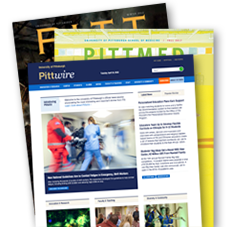Pitt to Celebrate 100th Anniversary of Voice Radio Transmission
PITTSBURGH-Reginald Fessenden, the prolific inventor and first chair of Pitt's electrical engineering department whose pioneering work with radio transmission led to radio as we know it today, will be celebrated at a symposium on Nov. 11.
Reginald who, you ask?
Fessenden, the "Father of Radio," is not as well known as his contemporary inventors-Edison, Marconi, and Tesla-but it was Fessenden's scientific daring that, in the end, gave us one of the most powerful communication tools in history: radio.
According to Fessenden's own records, he successfully made the first long-distance transmission 100 years ago when he broadcast his voice and his violin performance over the Atlantic, startling and mystifying sailors who typically were listening for dots and dashes and the occasional seagull, and heard "O Holy Night" instead.
But this dramatic moment was hardly his only contribution to the quality of life we enjoy today. Fessenden's prodigious genius also led to 500 patents, including the wireless telephone, the oscillator, the fathometer (an early version of sonar used in the search for the sunken Lusitania), the wireless compass, and the turbo-electric drive used in battleships. He also did pioneering work in light bulbs and was a proponent of alternating current. His theories, later proved accurate, audaciously challenged those of Edison and Marconi and prevail to this day.
Much of Fessenden's radio work was done while he was chair of the electrical engineering department at Western University of Pennsylvania, now the University of Pittsburgh. To commemorate Fessenden's role in radio's emergence, Pitt will host a symposium titled "The Birth of Radio and the Pitt Connection," from 8:30 a.m. to noon Saturday, Nov. 11, in the Benedum Hall Auditorium, corner of O'Hara and Thackeray streets, Oakland.
The first session, titled "The History of Radio," will feature emcee Larry Shuman, associate dean for academic affairs in Pitt's School of Engineering and professor of industrial engineering, and the following panelists:
o Charles Reichblum, KDKA's "Dr. Knowledge";
o Rick Harris, broadcasting historian and coauthor of the book When Radio Was Young (National Museum of Broadcasting, 1995);
o G. Alec Stewart, dean of Pitt's Honors College and amateur radio aficionado; and
o Marlin Mickle, Nickolas A. DeCecco Professor of Electrical and Computer Engineering and Telecommunications at Pitt.
The second session, on the future of radio, begins at 10:30 a.m. and will feature presentations by Mickle and Gerald Youngblood, CEO of FlexRadio Systems.
George Westinghouse lured Fessenden to the University in Pittsburgh because Westinghouse had already seen the engineer's genius and wanted him close at hand. Fessenden's invention of silicon-iron and nickel-iron alloys for the lead-in wires in electric light bulbs and the methods for sealing wires in a glass envelope had allowed Westinghouse to fulfill his commitment to light the 1893 World's Columbian Exposition in Chicago.
It was at the University that Fessenden developed the idea to use continuous high-frequency electromagnetic waves to transmit the human voice. This then led him to the "heterodyne principle" of amplitude modulation (AM), which eventually allowed us to hear such famous voices as Charles Osgood, Garrison Keillor, and Myron Cope.
Because of Fessenden's Pittsburgh connections-electrical and human-Western Pennsylvania became the incubator of modern radio. And in 1920, KDKA, owned by Westinghouse, aired the first commercial broadcast.
After seven years at the University of Pittsburgh, ending in the spring of 1900, Fessenden moved on and continued his experiments. In late 1906, according to his biography, an unplanned success occurred when a station he had built in Scotland "overheard" the voice of a Fessenden assistant who was giving instructions by wireless telephone from a Brant Rock, Mass., station to one in Plymouth, Mass. Then Fessenden made the world's first intentional voice "broadcast" from Brant Rock. His voice announced to the ships at sea that it was a test, then Handel's "Largo" from a phonograph, then Fessenden's own violin version of "O Holy Night" and his singing of one verse, then his reading of the New Testament Christmas story.
Fessenden's ideas, nurtured in Pittsburgh, took voice across the Atlantic, and the rest, as they say, is all-night talk radio.
Fessenden's grave marker, in Bermuda, contains a reference both to radio and sonar: "By his genius distant lands converse, and men sail unafraid on the deep." The world, still enthralled by the power of radio, shouldn't have to stumble across his grave to know his story.
To register for the conference, contact Sonia Bembic at 412-624-2640 or sbembic@engr.pitt.edu.
###
10/31/06/tmw
Media Resources
Schools of the Health Sciences Media Relations
For more information about Pitt's schools of dental medicine, health and rehabilitation sciences, medicine, nursing, pharmacy, and public health, click here >
To locate stories from health science schools prior to 2013, visit the UPMC news archives »
Urgent Question?
University of Pittsburgh news reps are available to answer urgent media inquiries. Outside of regular business hours (Mon-Fri, 8:30 a.m.-5 p.m.), please email us at media@pitt.edu.
News reps for University of Pittsburgh Health Sciences schools can be reached outside of regular business hours through the paging operator at 1+412-647-2345.


